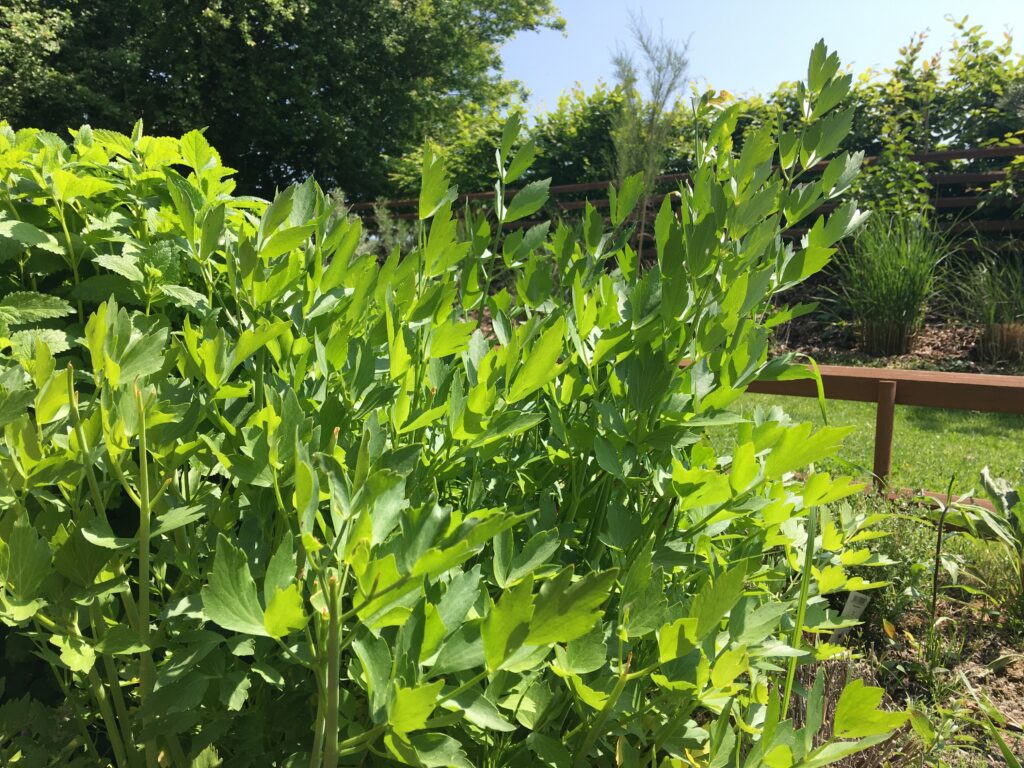In the past, lovage was widely cultivated and much more popular than it is today. And yet, with its intense aroma, it makes for a great ingredient in a wide variety of dishes, and is also a powerful healing herb thanks to its diuretic properties and ability to aid digestion.
Lovage is a striking, sturdy plant that grows up to 6½ feet / 2 meters tall. Its scent is similar to that of celery or parsley, but far more intense. In some European cultures, it’s popularly known as American celery or green Maggi (after the Swiss, umami-tasting seasoning called “Maggi”), which says a lot about the ways in which it can be used.
SMELLS LIKE CELERY, LOOKS LIKE CELERY, BUT ISN’T CELERY
Lovage is native to Afghanistan and Iran but you can find wild specimens in southern Europe, too. In most of the western hemisphere, it is grown in gardens. It has a strong branching rhizome and deep roots. The flowers are quite inconspicuous, as is common with myrrh trees, and they bloom in July and August. The leaves are also celery-like in shape.
Lovage has a number of uses in the kitchen, where it is used wherever celery or parsley leaves are typically used. It’s ideal when you want to take advantage of its strong aroma – in soups, sauces or salads, for instance. The young leaves are especially delicious in a salad.
THE LEAVES AND ROOTS HEAL
For medicinal purposes, the root, the rhizome, or the root along with the rhizome, are used. They should be taken in the fall of the 2nd or 3rd year of the plant’s life. Both the leaves and the rhizome should be washed and dried right away. The use of lovage in medicine has a long tradition, having been used in both ancient and medieval times. Due to its high content of essential oils, vitamins and other active substances, it helps with a wide range of health problems, although pregnant women and children should avoid it, and it should not be consumed for long periods of time.
A DIURETIC THAT CLEANSES THE BLOOD
Lovage is used for problems with the urinary tract, bladder and kidneys, and also for swelling, since it is a diuretic. It also has a good effect in treating stomach and intestinal problems, including, for example, dissolving gallstones. Those undergoing treatment for urinary and kidney stones may notice that lovage is often included in tea blends that are designed to help with these issues.
Because it purifies the blood, it promotes improved circulation and thus helps prevent gout and rheumatoid arthritis. It also strengthens crippled nerves and has an effect on the sexual organs – it harmonizes menstruation and increases libido. It can also be used externally by bathing, where it can heal poorly healing wounds, or by poultices applied on pigment spots on the skin, which it can lighten.
How to grow lovage
Lovage is an undemanding plant that can survive even in harsh, mountain climates. It is a perennial plant that you’ll enjoy in your garden for a long time, so there’s no need to plant it every year. The seeds germinate rather poorly and slowly, so it’s much easier to buy a young plant and plant it in a suitable habitat.
The soil should be rather moist (but not wet or muddy) and should not be impermeable or clayey. When planting, it’s sufficient to put a shovel of compost in the bottom of the hole in which the seedling is placed; fresh manure is not appropriate as lovage doesn’t like it. Make sure you dig the planting site well before planting, and expect the plant to grow very wide. You will therefore need to make sure that it has plenty of space around it.
Lovage is not sensitive to breezes or cold temperatures, and prefers sunny or slightly shaded sites. If the weather is hot, then regular and abundant watering will do it good. If you don‘t have a garden or want to have it quickly to hand, you can also grow it on your balcony, but a deep pot is essential – its root ball is really quite large. The following year, you can multiply your lovage by taking the plants that have separated from the clump. Each of these can form the basis of a new specimen.
WINTERING LOVAGE
A plant that grows in a bed overwinters very well, as low temperatures do not cause it any problems; just make sure to trim the stems. If you keep your lovage in a pot, bring it into a cool room for the winter to give it a winter rest. This can be finished as early as March or April. When you renew the watering, you will see that the young succulent leaves soon appear.
Lovage infusion for getting rid of excess water
You will need:
1 tbsp. chopped lovage root or leaves
2½ cups / 500 ml water
Directions:
Pour boiling water over the lovage, cover, and leave to stand. Drain after 10 minutes and drink one cup of the infusion in the morning and another in the evening, before meals. Do not take for more than 2 weeks. The infusion isn’t suitable for children or pregnant women.

Find out more in new issue of My Herbs magazine.

